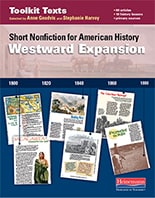
Imprint
Heinemann
Author(s)
Stephanie Harvey, Anne Goudvis
“We turn information into knowledge by thinking about it. These texts support students in using the Toolkit’s comprehension and thinking strategies as tools to acquire and actively use knowledge in history.”—Stephanie Harvey and Anne Goudvis
To support cross-curricular strategy instruction and close reading for information, Stephanie Harvey and Anne Goudvis have expanded their Toolkit Texts series to include a library of short nonfiction for American history with 10 all-new Toolkit lessons.
Building on selections from popular children's magazines as well as original articles, these engaging, age-appropriate texts will keep your active literacy classroom awash in historical resources that depict the controversies, issues, and dramas that shaped historical events, including the exploits of lesser-known individuals.
These short nonfiction texts for American history include:
- 10 comprehension strategy lessons for close reading in content literacy.
- Short nonfiction articles on a wide range of topics and at a variety of reading levels.
- A bank of historical images, primary source documents and artifacts, plus primary source documents and artifacts bibliographies, web sites, and ideas for online investigations.
- A Digital Companion Resource provides all of the texts, primary source documents, and the image bank in a full-color digital format so you can display them for group analysis.

